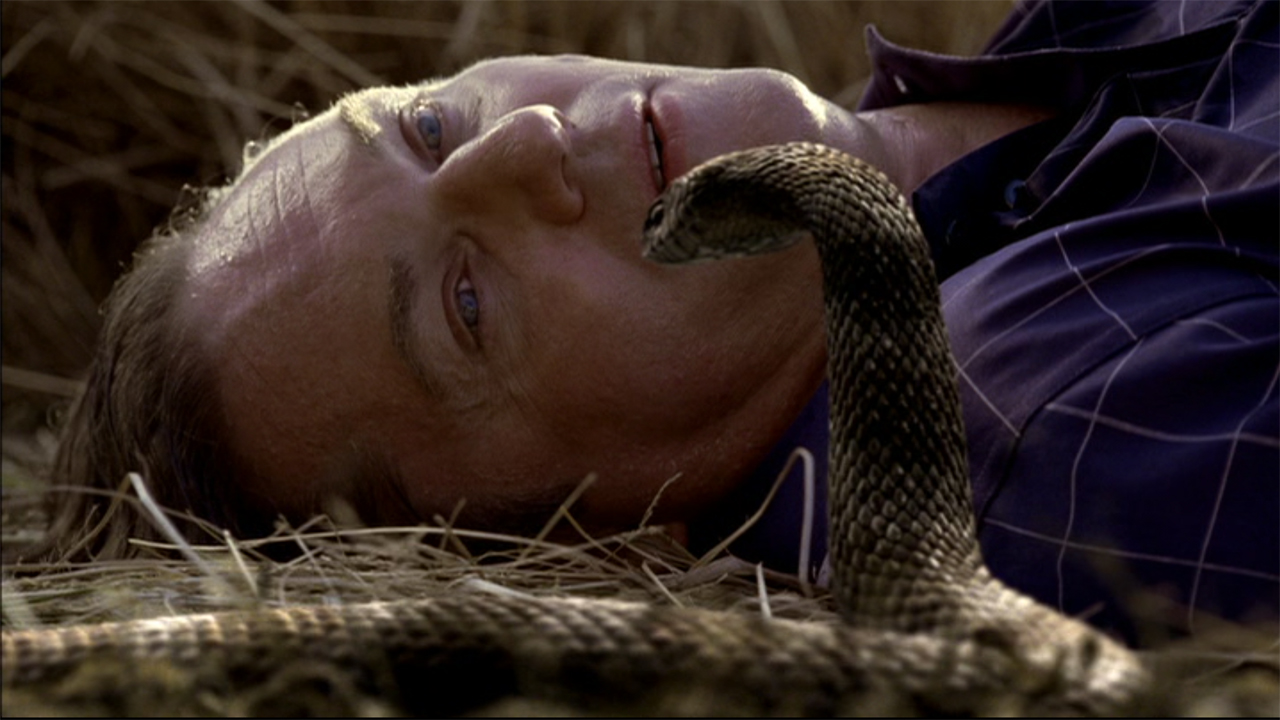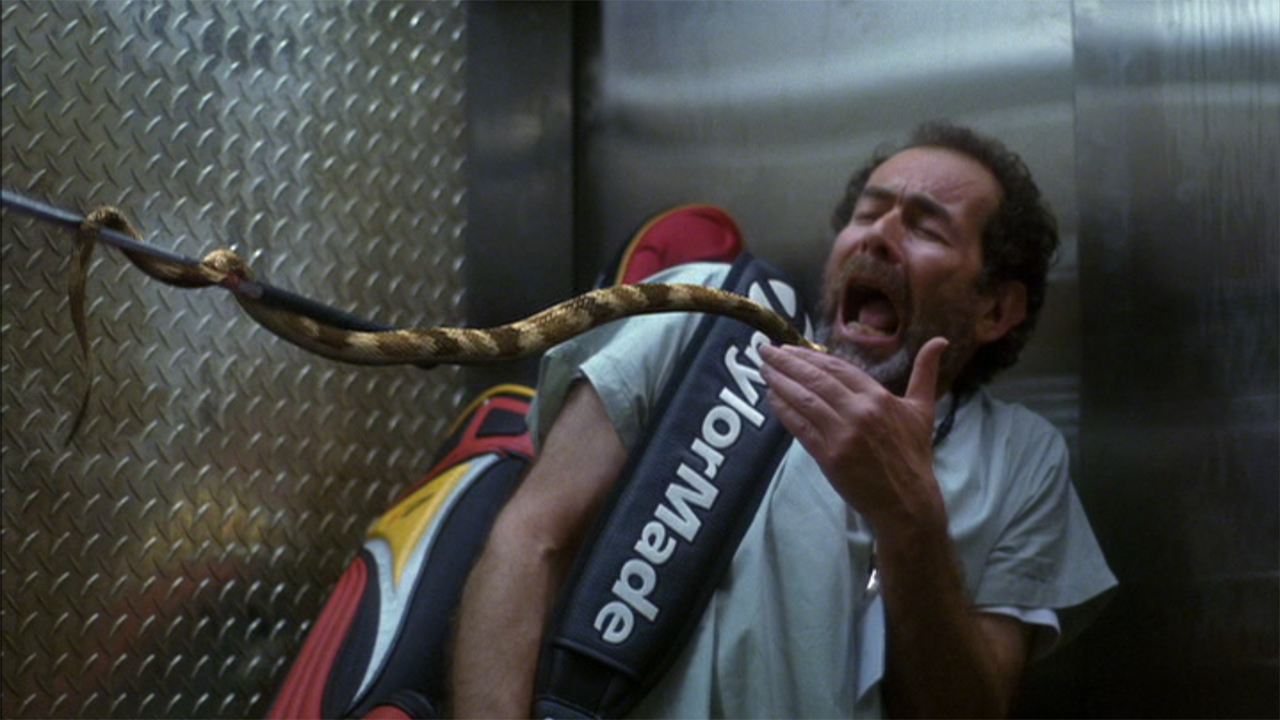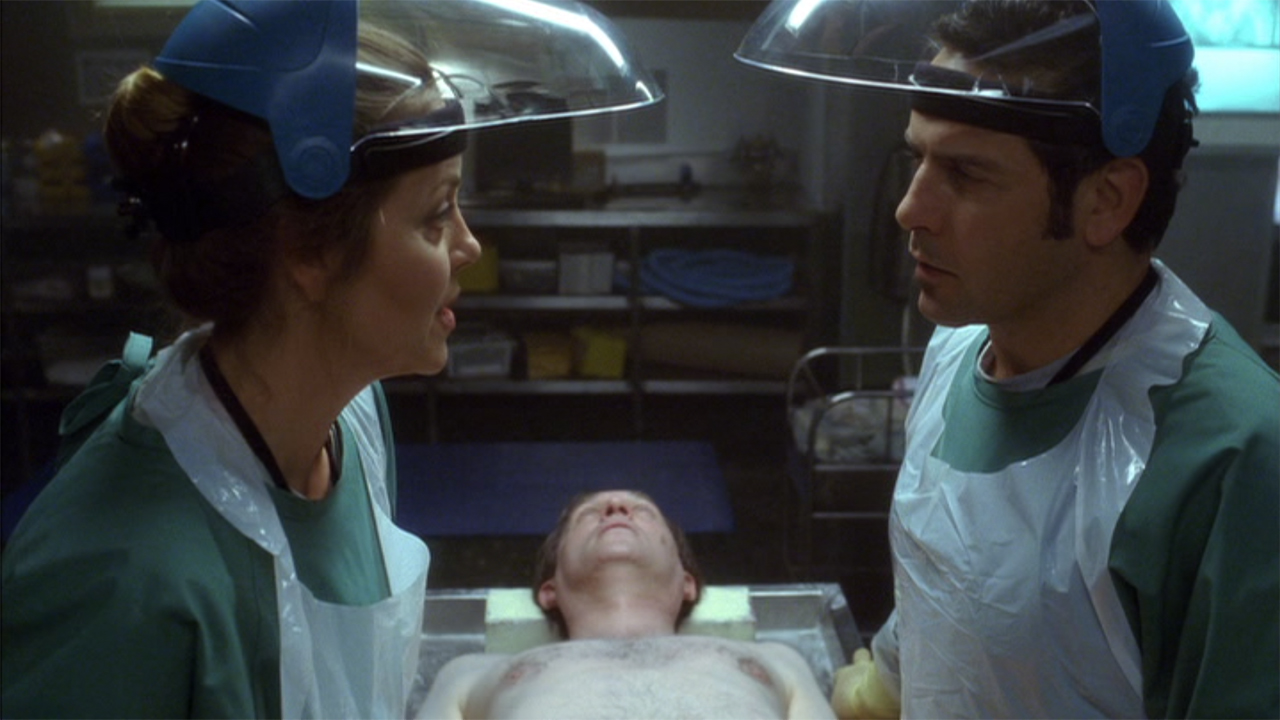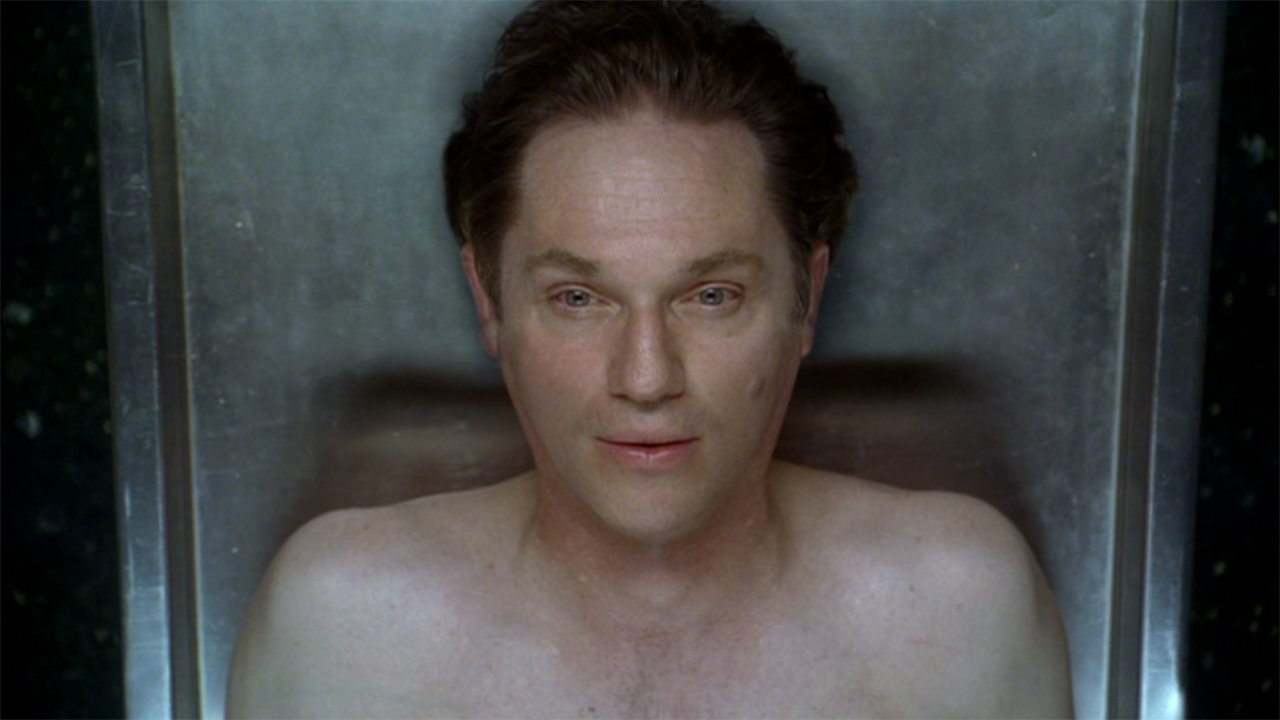Adapting Stephen King's Autopsy Room Four: Nightmares & Dreamscapes' Seventh Episode Is A Locked-In Terror
Stephen King tackles a fear that terrifies each and every one of us.

In my column a few weeks ago about the “The End Of The Whole Mess” episode of Nightmares & Dreamscapes: From The Stories of Stephen King, I lamented that there weren’t more filmmakers involved with the show who had past experience making Stephen King adaptations. It is one of the few macro issues with the TNT production – though one interesting aspect of the anthology series is that it at the very least features a number of actors who have multiple King credits on their filmographies.
“The End Of The Whole Mess” is the first Stephen King adaptation to feature Henry Thomas, and in subsequent years he has played parts in Mick Garris’ Desperation and the Mike Flanagan-directed duo of Gerald’s Game and Doctor Sleep. “The Fifth Quarter” created a female lead character for Samantha Mathis to play, and it was a role that not only followed her performance in 2004’s Salem’s Lot miniseries, but preceded her work in the first season of Under The Dome. And next week I’ll be taking a look at “You Know They Got A Hell Of A Band” starring Steven Weber, who played Jack Torrance in 1997’s The Shining miniseries, directed the Outer Limits episode “The Revelations Of 'Becka Paulson,” and is also in Desperation.
“Autopsy Room Four” is also part of that legacy (not counting the fact that its supporting cast includes Robert Mammone, who is also in “The Fifth Quarter”). Playing protagonist Howard Cottrell in the adaptation is Richard Thomas – who audiences of older generations may know best as John-Boy on The Waltons. Stephen King fans, however, know him from a very different role in a very different production, having played adult Bill Denbrough in the beloved 1990 IT miniseries.
The second episode of Nightmares & Dreamscapes directed by Salem’s Lot’s Mikael Solomon (who also helmed “The End Of The Whole Mess”), “Autopsy Room Four” credits its teleplay to Emmy-nominee April Smith, and it makes a compelling argument in and of itself that the anthology series was canceled far too soon. It was paired with the show’s finale in TNT’s two-hour Wednesday night block, and debuted on August 2, 2006. It’s a terrific blend of horror and humor and a delight to spotlight in this week’s Adapting Stephen King.

What “Autopsy Room Four” Is About
Like “The Road Virus Heads North,” “Autopsy Room Four” is not a short story from the 1993 omnibus Nightmares & Dreamscapes, but instead can most easily be found in the 2002 collection Everything’s Eventual (it was technically first published in a limited-edition book called Six Stories in 1997). It’s a horror tale with origins that aren’t particularly complex, as Stephen King wrote it based on inspiration from a common fear: being declared dead while unable to tell anybody you’re alive.
Everyone has heard spooky legends about coffins being dug up in cemeteries and found to have scratch marks on the inside, but for Stephen King, the version of a premature burial story that long stayed with him was the seventh episode of the 1955 anthology series Alfred Hitchcock Presents. Titled “Breakdown,” it was directed by Hitchcock himself, and King recalls being terrified by it in his note about “Autopsy Room Four” in Everything’s Eventual. He writes,
When I was a kid of seven or so, the scariest TV program going was Alfred Hitchcock Presents, and the scariest AHP – my friends and I were in total agreement on this – was the one starring Joseph Cotten as a man who has been injured in a car accident. Injured so badly, in fact, that the doctors think he's dead. They can't even find a heartbeat. They are on the verge of doing a postmortem on him – cutting him up while he's still alive and screaming inside, in other words –when he produces one single tear to let them know he's still alive.
Not being one to hide his influences, Stephen King mentions this Alfred Hitchcock Presents episode multiple times in his short story.
Your Daily Blend of Entertainment News
What actually made the whole thing come together, though, was figuring out the ending. As much as he appreciates Joseph Cotton’s life-saving tear, Stephen King writes in Everything’s Eventual that “touching isn't in [his] usual repertoire,” and so he started thinking about a different way that a doctor could discover that a corpse isn’t actually a corpse. He eventually had a eureka moment: the “dead body” could get an erection. King notes,
When my own thoughts turned to this subject, a more – shall we say modern? – method of communicating liveliness occurred to me, and this story was the result.
“Autopsy Room Four” is wholly told from the perspective of Howard Cottrell – a stock broker, a golf fanatic, a Michael Bolton look-alike, a Vietnam veteran, and a man presumed dead. While playing a round at the Derry Municipal Country Club, he is bitten by a snake while hunting for an errant ball. The side effect of the venom is instant full body paralysis, but an elderly doctor who first attends to him misses his heartbeat and declares him dead upon the discovery of his body.
Howard can’t so much as twitch a finger as he is brought in a body bag from the golf course to the morgue, but he is fully cognizant of everything that is going on around him. While attending physician Dr. Katie Arlen illegally hands the lead on the autopsy to her handsome intern Peter, on whom she has a crush, Howard desperately tries to figure out a way to show that he is alive before a large pair of scissors is used to cut through his sternum and open his chest cavity.

How Nightmares & Dreamscapes’ “Autopsy Room Four” Differs From The Short Story
In Stephen King’s “Autopsy Room Four,” not only is Howard Cottrell locked inside his own body, but the reader is trapped along with him. Everything that happens in the short story is communicated based on the protagonist’s own sensory perception – from people and objects that move in and out of his unmoving eye line, to the music that is played over a boom box, to his reaction to the doctor’s onion breath.
The Nightmares & Dreamscapes: From The Stories of Stephen King episode starts from the first person perspective, as we watch through the eyes of Howard (Richard Thomas) as he is zipped up in a body bag, and there is voice over narration from beginning to end – but the episode veers away from the one channel presentation of the short story, and expands the narrative beyond what the paralyzed man can see, smell, hear, taste, and feel.
For example, the adaptation has a much bigger role for Rusty (Linc Halser), the obnoxious idiot who gets kicked out of Autopsy Room 4 toward the beginning of Stephen King’s short story and doesn’t appear again until the very end when he charges in with information about the snake. Because the episode isn’t tied to Howard, the narrative regularly checks in on Rusty, and so we actually get to see him first try to steal Howard’s golf bag, and then discover the snake inside while riding with Mike the Orderly (Brian Lipson) in an elevator.
And that’s just one of the changes.
Some of the alterations feel a bit arbitrary (like having Howard be on a vacation during his accident instead of at his home golf course), but April Smith makes a number of smart calls in her teleplay – such as giving Howard’s sexual history a bit of drama. There are extra scenes included with Howard and a girlfriend named Angela (Jude Beaumont). It’s revealed through memories of their third anniversary together that Howard is impotent as a result of an injury sustained in Vietnam – which makes his erection at the end of the story all the more triumphant. Furthermore, there are added scenes of her in the hospital with Howard’s golfing partner (Paul Gleeson), and she reunites with him after his paralysis abates.
Surely due to budgetary reasons, the Nightmares & Dreamscapes episode doesn’t have the doctors listening to a tape of the Rolling Stones while they work (totally drowning out the very quiet hum that Howard is able to produce with his lips), but most of the big events in the short story are translated from the page to the screen – with much of King’s internal dialogue used in the voice over narration. There is a minor plot detour taken that is not from King’s story, with the doctor’s briefly pondering the possibility that their corpse was struck by heat lightning, but it’s ultimately not a particularly significant change.
Ending shortly after Howard is freed from his paralyzed state, the adaptation doesn’t feature anything from Stephen King’s “Afternote” in “Autopsy Room Four.” This includes details about the snake responsible for all the craziness (a fictional thought-extinct species called a Peruvian boomslang), and the revelation that Howard and Dr. Arlen dated for a few months following his near-death experience. (The protagonist notes that their relationship ended because he was unable to become aroused if she didn’t wear rubber gloves.) Given the addition of the relationship with Angela, it makes sense that this “punchline” was left out.

Is It Worthy Of The King?
When it comes to ranking episodes of Nightmares & Dreamscapes: From The Stories of Stephen King, there is a Top 4 and a Bottom 4, and there is a pretty significant gap between them. The latter aren’t terrible (all of them are watchable), but the former are elite, fantastic adaptations of Stephen King’s short stories. As I’ve noted in previous columns, my Top 3 in order are “Umney’s Last Case,” “Battleground,” and “The End Of The Whole Mess,” and rounding out the group is “Autopsy Room Four” as – appropriately – my fourth favorite.
A small part of me laments the fact that the adaptation doesn’t lock the audience into Howard’s body like Stephen King’s story does, but, in a sense, that makes it all the more admirable for still being able to translate the terror that the protagonist is experiencing. The reason premature burial is a common fear is because any human person can perfectly understand the hell it would be, and you empathize with Howard’s plight. It’s particularly effective because of Richard Thomas’ performance.
The changes and additions that April Smith makes with the teleplay are interesting ones that build nicely on the foundation built by Stephen King, with the standout being the addition of Angela and Howard’s bedroom issues. It’s a shame more isn’t done with the heat lightning idea, as it is an underdeveloped red herring, but in the tally of good ideas vs. bad ones, there are way more of the first.
It’s not as stylistically bold as the best of the best episodes of Nightmares & Dreamscapes (which is to say the aforementioned titles in the Top 3), but it’s a fantastic treatment of Stephen King’s story.

How To Watch Nightmares & Dreamscapes’ “Autopsy Room Four”
The good news? In a couple weeks I’ll be able to write about how Constant Readers can find ways to watch the readily-available Stephen King adaptation Desperation. The bad news? Nightmares & Dreamscapes remains unstreamable. As I’ve noted in the last six weeks of this column, the anthology series is neither available on any streaming service, nor is it available for digital rental or purchase at any online outlet. It remains the case that the only way to legally watch the show is by buying the three-disc DVD set that was first released only about three months after the finale aired.
Speaking of the finale, next week’s column will conclude the exploration of Nightmares & Dreamscapes: From The Stories of Stephen King with a dive into the aforementioned “You Know They Got A Hell Of A Band” – a story heavily inspired by the author’s passionate love of rock ‘n roll. You’ll be able to find the piece here in the CinemaBlend TV section next Wednesday, and for now you can discover all of my previous Adapting Stephen King features by clicking through the banners below.







Eric Eisenberg is the Assistant Managing Editor at CinemaBlend. After graduating Boston University and earning a bachelor’s degree in journalism, he took a part-time job as a staff writer for CinemaBlend, and after six months was offered the opportunity to move to Los Angeles and take on a newly created West Coast Editor position. Over a decade later, he's continuing to advance his interests and expertise. In addition to conducting filmmaker interviews and contributing to the news and feature content of the site, Eric also oversees the Movie Reviews section, writes the the weekend box office report (published Sundays), and is the site's resident Stephen King expert. He has two King-related columns.
